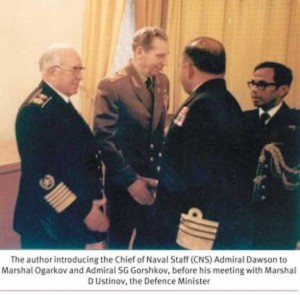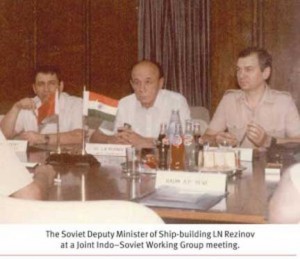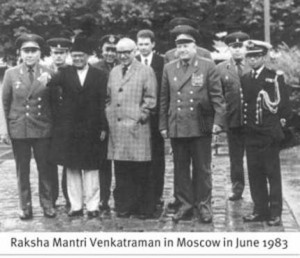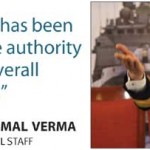The launching of the Arihant by the Prime Minister (PM) on 26th July 2009 has hopefully, at last, partially lifted the top security veil over the Advance Technology Vessel (ATV) Project. In that light, to the extent feasible, without impinging on any national security concerns, an attempt is being made here, to fill the void and provide some answers to the reader’s genuine concerns.
In the western world, Admiral Rickover’s name is synonymous with the nuclear submarine. He was an engineer in the United State’s (US) Navy and is globally considered to be the father of the nuclear submarine arm. He was a one man team to see through the US nuclear submarine project from concept design to construction and delivery. To achieve that end, he had to battle all his way through the Senate, the Navy and the Industry. He used his considerable technological/managerial administrative skills and political acumen, to his full advantage. Only then was he able to achieve his ends.1,2
 At that stage, it would have been beyond Britain’s (UK) resources to go in for a purely indigenous nuclear submarine. The US was generous enough to lend a hand by transferring a submarine reactor and its linked technology to it. Later, the British Navy (RN) opted for the fitment of US Submarine Launched Ballistic Missiles (SLBM) also. The US was, however, not prepared to do the same for France. France and USSR independently developed their nuclear submarine force. In this area China got considerable assistance from the USSR till the mid 60s. All such assistance ceased after the relationship soured. China continued to work on its own, with limited success. It is only after the breakup of the Soviet Union and the consequential economic collapse that finally brought the Russian Federation (RF) and China together again. Since then, considerable progress has been made and the Chinese Navy [PLAN] can now claim to have two operational class nuclear submarines (Type 093 & 094).
At that stage, it would have been beyond Britain’s (UK) resources to go in for a purely indigenous nuclear submarine. The US was generous enough to lend a hand by transferring a submarine reactor and its linked technology to it. Later, the British Navy (RN) opted for the fitment of US Submarine Launched Ballistic Missiles (SLBM) also. The US was, however, not prepared to do the same for France. France and USSR independently developed their nuclear submarine force. In this area China got considerable assistance from the USSR till the mid 60s. All such assistance ceased after the relationship soured. China continued to work on its own, with limited success. It is only after the breakup of the Soviet Union and the consequential economic collapse that finally brought the Russian Federation (RF) and China together again. Since then, considerable progress has been made and the Chinese Navy [PLAN] can now claim to have two operational class nuclear submarines (Type 093 & 094).
The realization of the need for a nuclear submarine came a little late to India. One would recall the time, when the government was not willing to consider acquiring even a conventional submarine for the purpose of training anti-submarine crews on surface ships. For this purpose, the Navy had to make do with RN submarines during annual Commonwealth exercises. The reason given was that the submarine was an offensive weapon and ours is a defensive navy. Only in the late 1960s a change of mind took place and the first squadron of I641 submarine was inducted into the Navy from the Soviet Union (USSR). After two decades, the HDW submarine from Germany, followed by 877EKM submarines from USSR were also added to the inventory.
The aspirations for a nuclear powered submarine surfaced soon after the Bangladesh war. Presumably, Indira Gandhi, the then Prime Minister, was traumatized by the unexpected entry of the US Aircraft Carrier Task Force into the Bay of Bengal. To counter this move and demonstrate their solidarity with India, Admiral Gorshkov is believed to have ordered one of the Soviet nuclear submarines in the vicinity to surface. This had a salutary effect on the situation. This one single incident demonstrated to the Prime Minister the overbearing significance of a nuclear submarine in the strategic scenario.3
Accordingly, Director of Marine Engineering (DME) at Naval Head Quarters (NHQ) was encouraged to initiate a technical feasibility study for an indigenous nuclear propulsion system (Project 932). DME was only keenly waiting for such an opportunity. Rear Admiral PN Aggarwal who was then a Deputy Director steered the case through the Defence Ministry (MoD). He later headed the Project team at Bombay in collaboration with the Bhabha Atomic Research Centre (BARC) scientists. Vice Admiral Bharat Bhushan followed suite. Later he became the Director General of the Advanced Technology Vessel (DGATV) programme, also.4,5
The realization of the need for a nuclear submarine came a little late to India. One would recall the time, when the government was not willing to consider acquiring even a conventional submarine
The programme concept, as a complete weapon platform, emerged much later. In 1982, the Soviet Chief of General Staff, Marshal of the Soviet Union, NV Ogarkov, is believed to have conveyed to the PM the willingness of USSR to provide assistance to India in the development of a nuclear submarine. At the time, the Navy was not too enthusiastic about it. They had, after decades, just begun the exercise of rebuilding the conventional force levels and could not think of diverting their meager budget resources to support such an exorbitant venture.
The government decided to follow up the offer. A high level technical team was appointed with Dr Raja Rammanna as the leader. Vice Admiral MK Roy, Dr PR Dastidar, Director BARC, Vice Admiral BR Chowdhury, the DME, Admiral VS Shekhawat an experienced submariner, and Mr BS Ramaswamy, the Additional Financial Adviser (Defence) formed the initial core team. The Naval Attaché (USSR) served as the facilitator at Moscow. The acquisition of a nuclear submarine and training of the crew was taken up first. This fructified, finally, in the lease of the INS Chakra.
Some eminent analysts have postulated that such transactions (including the lease of ‘Nirpa’) have been possible because the IAEA jurisdiction does not extend to bilateral agreements involving Nuclear Weapon States transferring technology/hardware/fuel, etc, in respect of nuclear powered warships/submarines to any other party.6,7
 Further, the 1993 Lucerne NSG amendment (incorporated in Parts 1 and 2 of IAEA document INFCIR/254 revision 1) should prevent ala Chakra/Nirpa type transfer by China to Pakistan, with China being formally inducted into the NSG since 10 June 2004. In this context, all Indo-Soviet agreements prior to 03 April ‘92 would fall outside the scope of this amendment. This would include Nirpa as well as the same, presumably, flows out of the parent agreement for Chakra, concluded in the early 1980s.
Further, the 1993 Lucerne NSG amendment (incorporated in Parts 1 and 2 of IAEA document INFCIR/254 revision 1) should prevent ala Chakra/Nirpa type transfer by China to Pakistan, with China being formally inducted into the NSG since 10 June 2004. In this context, all Indo-Soviet agreements prior to 03 April ‘92 would fall outside the scope of this amendment. This would include Nirpa as well as the same, presumably, flows out of the parent agreement for Chakra, concluded in the early 1980s.
Seeking of assistance in design, development and construction of an indigenous nuclear powered submarine was taken up next. It was clear, from the very beginning, that to achieve success in such a complex, high technology programme, all technical and industrial resources of the country, in the Public and the Private sector, would need to be harnessed. A special architecture had to be evolved to accomplish a Publicfor-Private Partnership (PPP) that could achieve the cutting edge goals and retained under the highest possible national security umbrella. This gave birth to the ambitious Advanced Technology Vessel Project (ATV), under the Defence Research & Development Organization (DRDO).
The ATV pioneering team under the DRDO was lead by Vice Admiral MK Roy as the Director General. His team of core specialists comprised the following:
- Project Director (Finance): Mr AK Mitra.
- Project Director (Administration): Rear Admiral OP Sharma.
- Programme Director (Technical & Coordination): Rear Admiral AP Revi.
Heads of Work Centres
- Director (DMDE): Vice Admiral IC Rao.
- Director, Submarine Building Centre: Rear Admiral PN Aggarwal.
Director (PTC): AN Prasad at BARC/Kalpakam.
AK Anand and Rear Adm Gurmit Singh.
- Director – (Submarine Design Bureau): Rear Admiral RS Chaudhry.
- General Manager (BHEL): Dr A Gopalakrishnan.
The apex body for the programme was set up on the lines of the Integrated Guided Missile Programme model. The PM, who was also the Raksha Mantri, was in the chair.
The challenges faced were many, acute and diverse. Never before had submarine design, even of a conventional type or a specialized nuclear reactor capable of operating in the ocean environment, been seriously attempted in India. The submarine hull and system design was taken on by the Navy’s in-house Design Bureau. This task was entrusted to Rear Admiral Raj Chaudhry, who had a competent team, theoretically trained in USSR, UK and Germany. This being their first practical assignment, was the main handicap. Being from such diverse design backgrounds, the first task was to bring them all on to the same grid. Reconciling the differences in design concepts was itself a herculean task. The USSR believed in double hull for their submarines. The western countries, on the other hand, believed in single hull designs. The design codes/coefficients/softwares, etc were exclusive and specific to each. Since design was being validated by the special consultants, the single hull design choice had, perforce, to be put on the back burner, for the moment.
 The primary system design for the propulsion unit was equally challenging. The only saving grace was that the scientists and engineers with the Department of Atomic Energy (DAE) had acquired considerable expertise in the field of indigenous design and development of nuclear power plants ashore. In this case, the criteria of compactness to fit into a submarine hull, and the need to safely function from a mobile platform, which is rolling, pitching, operating under steep trim conditions, along with crash diving and emergency surfacing, etc, were all conditions necessarily to be met. The DAE was confident that their scientists would be able to cope with all these stringent conditions without any external assistance. Hence, initially, no design assistance was envisaged even for the unique reactor fuel core. Test and full endurance trial were planned at Prototype Test Centre (PTC) at Kalpakkam.
The primary system design for the propulsion unit was equally challenging. The only saving grace was that the scientists and engineers with the Department of Atomic Energy (DAE) had acquired considerable expertise in the field of indigenous design and development of nuclear power plants ashore. In this case, the criteria of compactness to fit into a submarine hull, and the need to safely function from a mobile platform, which is rolling, pitching, operating under steep trim conditions, along with crash diving and emergency surfacing, etc, were all conditions necessarily to be met. The DAE was confident that their scientists would be able to cope with all these stringent conditions without any external assistance. Hence, initially, no design assistance was envisaged even for the unique reactor fuel core. Test and full endurance trial were planned at Prototype Test Centre (PTC) at Kalpakkam.
Primary system, up to the steam generator, design and development became the exclusive responsibility of BARC, with Naval Nuclear Engineers over-seeing the work. The down stream secondary system was entrusted to Defence Marine Engineering Design & Development Establishment (DMDE) at Hyderabad. The prototype Pressure Water Reactor (PWR) for the submarine became critical inside the submarine pressure hull capsule at Kalpakkum on 11 November 2003 and was declared operational on 22 September 2006.8, 9, 10,11
Since the indigenous industry did not have suitable test facilities, a dedicated Machinery Test Centre (MTC) was set up at Vishapatnam. For submarine building activity, an exclusive Submarine Building Centre (SBC) was created, with all facilities inclusive of the means to load and replace reactor fuel core, with the submarine along-side.12
It would be observed that, in the initial phase, ending 1989-90, when the USSR disintegrated, the ATV’s achievements were considerable. A sound foundation had been laid, with a high powered, fast track, empowered management system in place. All the requisite institutions/infrastructure were conceptualized, sanctioned and launched from abi-ni-tio, in record time. Bharat Heavy Plates & Vessels at Vizag, Larson & Tubro at Hazira, Mazagon Dock Ship Building Yard, Bharat Heavy Electrical and Bharat Electronics at Bangalore were all roped in. Full cooperation was extended by all concerned, including the Navy, DRDO, DAE and the Public/Private sector undertakings concerned, particularly in making available their best talents for the task envisaged.
Since the indigenous industry did not have suitable test facilities, a dedicated Machinery Test Centre (MTC) was set up at Vishapatnam. For submarine building activity, an exclusive Submarine Building Centre (SBC) was created
The duration for execution in our case is often perceived to be very high. As would be seen from the two instances illustrated below, that the Indian performance is comparable to any global standards. These are particularly so, taking into account the severe technology denial regime that India was subjected to and its location, at the time, on the learning curve.
The time frame in which USA was able to induct its first operational nuclear submarine could be used as a yardstick for comparison, bearing in mind that at their starting point, they had a huge industrial base and considerable experience in design, development and construction of conventional submarines.
Time Frame in Respect of USS Nautilus.
- December 1944 – Authorized urgent R&D project for nuclear propulsion.
- August 1950 – Construction of “Nautilus” authorized.
- January 1952 – Keel laid.
- January 1954 – Nautilus launched.
- December 1954 – Basin Trials.
- January.1955 – Sea trials.
- May 1955 – Shake down cruise.
- 15 Aug 1960 – Nautilus joined the fleet.
China’s Experience with SSN 093.
China took more than 16 years to commission even its second generation SSN, Type 093 – in spite of its massive conventional submarine programme and their head start on the first generation nuclear submarine and extensive technological and material support from Russia.13
- Construction began – 1990.
- Launched – December 2002.
- Commissioned – End 2006.
At the same time, it must be admitted that in the case of India, considerable improvement in time frame could have been effected, had the establishment relaxed some of the crippling internal security restrictions. Even consultation with the Navy’s own professional Directors (designated watchdogs for the Navy) was prohibited. Also, independent professional/technical audit requirements were put aside on security grounds. One CNS, on advice from his Chief of Material (COM) and Assistant Chief of Material (ACOM), in the late 80s, is believed to have exercised his ‘Nelson’s eye’ option and some informal involvement of professional Directors were made possible. That was soon clamped down with the next incumbent. Even now, it is considered not too late to review this policy.14
It is also incorrect to believe that one of the major causes of time overrun was due to the Navy not sparing officers on long term basis for this project. On the contrary, records would show that key design personnel have been allowed to be retained in the project from a Lieutenant’s rank to Vice Admiral. In filling senior vacancies, however, there is a perception, that in recent times, sufficient weightage was not being given to aptitude and commitment to the project. The emphasis has been more on not leaving any senior billets vacant. This demoralizes the team. R&D is not every ones cup of tea. The choice of Admiral Ravi Ganesh was exceptional. A former Commanding Officer of Chakra, with his experience and caliber was an ideal choice at the helm of affairs. Mid-stream changing of QRs and the devastating effect on USSR, post perestroika, also took its toll.15
The most crucial phase has only just begun. Notwithstanding the fanfare that accompanied the launching, the path ahead is not a bed of roses. All machinery would have been bench tested at the manufacturers and MTC before installment. Now, after floatation of the boat in the basin, they would need to be systematically proven singly, as a sub-system and finally as a whole, before attempting harbour trials. The Primary Reactor system will also take some time to attain the state of criticality. Only after completing the full range of Basin trials would the boat proceed, in stages, for harbour and preliminary sea trials – initially on the surface. During this process, deperming, demagnetization and extensive noise and vibration trials, etc would also be undertaken, at the designated trial stations. Thereafter, full range of sea trials would be attempted. It will include deep diving in planned stages.
Emergency, surfacing/diving and reactor shut down drills including speedy maneuver response, etc would also be exercised. This being our first attempt, break-downs and re-work must be anticipated and accordingly provided for. The weapon and sensor trials would follow, some in parallel, others during dedicated trials accompanied by supporting ships, submarines and aircraft, as appropriate. Only after all these tasks are fully met and the shipyard’s harbour and sea acceptance trials satisfactorily completed, would the boat be ready for commissioning into the Navy. Thereafter, the submarine would be put through its paces by the crew and finally worked-up with the fleet under the watchful eyes of Flag Officer Submarine (FOSM) and the Fleet Commander.
In this context, a serious case study of the loss of USS Thresher and Scorpion during the trial phase would be a worth while exercise.16
Notes
- “Rickover of the Nuclear Navy – the Discipline & Technology”. – Francis Duncan.
- “The Reckover Effect” – Theodre Rockwell.
- “India & Pakistan in War & Peace” – p222 – JN Dixit.
- “South Asian Nuclear Security Dilemma” – p58 & 88. – Lowel Dittmer.
- On 15 Nov 1972 – PM Indhira Gandhi declared in Parliament – the decision to conduct PNE and that nuclear propulsion design for submarine was under examination. – 15 Nov 1972.
- USI seminar “Indo-US relation – domestic dimensions”. – K Subramaniam – 14 Dec 2005.
- IDSA Seminar “Policy of assurance of supply of nuclear fuel” – Balachandran/- Ambasador Raj Goplalan. – 03 July 2009.
- Dr Khakodkar’s statement to the press. – Times of India. – 03 Aug 2009.
- “India’s Strategic Submarine Project” – Mark Gorwitz.
- “The Perils of Deterrence by half a measure” – pages 646 to 654. – Mr Bharat Kannard.
- “Sinking or Swimming” – Out Look – p 18/19 – Krishna Prasad. – 07 Aug 1996.
- “Nuclear arm” Front Line – TS Subramanian – 28 Aug 2009.
- Strategic Digest. Volume 37. No. 11 – Nov 2007.
- “Naval Acquisition Matrix” Rear Admiral. AP Revi – p 85. India Defence Review Vol. 21(4) – Dec 2006.
- “Just one shark in the Deep blue ocean” p 20-21 – Outlook. – R Adm K Raja Menon. – 10 Aug 2009
- “Death of the Thresher” – Norman Polmane.





Peculiar article, totally what I was looking for.
Thank you for a very informative Article. I just wish to inform the author, Rear Adm AP Revi, that Rear Admiral R S Chaudhry passed away on 2 Nov 2014. I lost a collegue and a dear and valuable friend. IDR may like to publish an obituary.